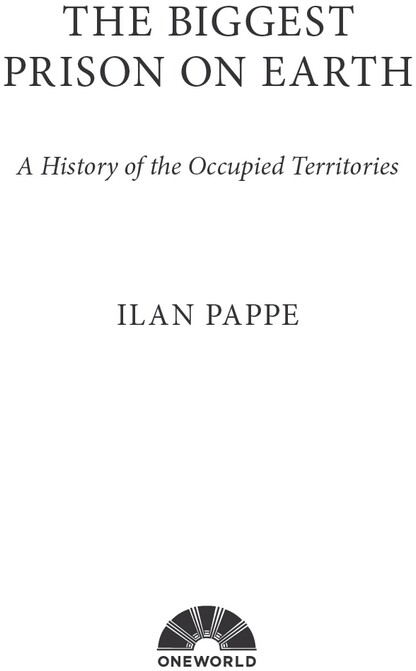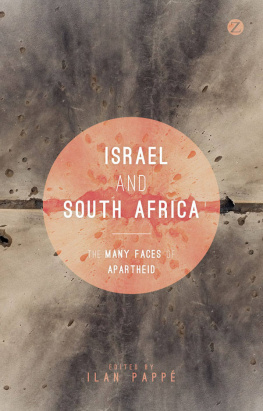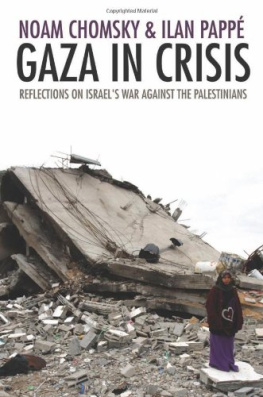Also by Ilan Pappe and published by Oneworld
The Ethnic Cleansing of Palestine

To the Palestinian children, killed, wounded and traumatized
by living in the biggest prison on earth.
Contents
List of Maps
Preface: One Hill, Two Prisons and Three Agencies
The University on the Hill
Givat Ram, the Hill of Ram, is a sprawling, hilly neighbourhood on the very western edge of present-day Jerusalem. Various government ministries, the Knesset, part of the Hebrew University and the Bank of Israel are located there. Israelis of a certain age, ethnic origin and socio-economic background have developed a great nostalgia for the place. The hill makes a very brief and pastoral appearance in Amos Ozs first and most famous novel, My Michael , published in 1968. It is the place where a small herd of sheep graze alongside the Prime Ministers Office. There are no sheep to be seen these days and the grazing fields of yesteryear are long gone. They have been replaced by an elaborate system of highways, metal gates, suspension bridges and a rather beautiful rose garden.
It is highly unlikely that sheep were to be found anywhere near the Prime Ministers Office when Ozs book was first published. However, sheep did graze this hillside when the rural Palestinian village of Sheikh al-Badr was situated there. A few of its houses still remain, next to the American hotels frequented by Israeli members of the Knesset who do not live in Jerusalem. The village was gradually swallowed by the city, becoming part of the urban sprawl until it was ethnically cleansed by Israeli forces in 1948. It was a famous part of the city, as it overlooked one of Jerusalems best-known landmarks: the Valley of the Cross. Tradition has it that the tree that provided the wood for Christs cross stood there and this is why it is said that on that spot Greek Orthodox monks built an impressive monastery, still there today, albeit surrounded by new Jewish neighbourhoods and ring roads.
West of the monastery lies one of the two main campuses of the Hebrew University in Jerusalem. It was built on land confiscated from Sheikh al-Badr and sold to the university by the Israeli Custodian of Absentee Property (allegedly held pending a decision about its future, but in reality sold to any Jewish individual or enterprise prepared to pay the ridiculously low price for it). Until 1948 the university was situated on Mount Scopus, which became a no mans land, an island within the Jordanian party of the city, and therefore inaccessible. After the June 1967 war, many of the Givat Ram campuss departments were transferred back to the old campus on Mount Scopus, which was then expanded significantly over confiscated Palestinian land.
North of the newly built campus, and at roughly the same time, a new home for the Israeli government was erected. Whereas the buildings of the campus were modest in appearance and laid out with pleasant lawns and accompanying greenery, the serene charm of this hilltop did not apparently inspire the architects who designed the government site of the Jewish State. Paying little attention to the pastoral scenery or its biblical heritage, they opted for what look like huge lumps of concrete spreading all over the hill, scarring the natural beauty of this crest of the Jerusalem mountains.
In summer 1963 a group of unusual students were enrolled on this campus for a month-long course. Almost all of them had a legal background of one sort or another. Some were members of the military administration that was controlling the areas in which the 1948 Palestinians (the Israeli Arabs as they were called then) lived under a strict rule that robbed them of most of their basic rights. Others were officers in the legal section of the Israeli army or officials of the Ministry of the Interior, and one or two were private lawyers.
They had been invited by the Department of Political Science in the Hebrew University. The course included lectures on military rule in general and on the political situation in the West Bank and the Gaza Strip, as well as a discussion on the lessons to be learned from Israels military rule in the Sinai and Gaza in 1956 and inside Israel since 1948. A short introduction to Islam was also part of the curriculum and it closed with a lecture on the 1948 ethnic cleansing of Jerusalem (though of course not described in this manner by the lecturer, who probably referred to it as Operation Yevusi of April 1948), in which scores of Palestinian villages were wiped out and their inhabitants expelled. This, reported one of the participants, was followed by a celebratory meal and everyone was in an excellent mood.
Their presence on Givat Ram in 1963 was part of a new overarching military strategy initiated by the Israeli Chief of the General Staff. The strategy was presented by the CoGS to the army on 1 May 1963 and was meant to prepare the army for controlling the West Bank as an occupied military area.
The West Bank, of course, was not yet occupied, but the fact that four years before the actual occupation the Israeli military was ready with a judicial and administrative infrastructure for ruling the lives of one million Palestinians is highly significant.
Discussion in Israel of how to run occupied Arab areas began during the Sinai operation, when, in collusion with Britain and France, the Jewish State tried to topple the Egyptian president, Gamal Abdel Nasser, in October 1956. As part of the campaign the Gaza Strip was occupied for a few months, and the sense among the strategists and army commanders was that the IDF (Israel Defense Forces) was ill-prepared for the mission. The lesson learned was that a more systematic approach was needed. The opportunity to devise a more structured strategy arose in 1963. That year, growing instability in Jordan led the chiefs of staff to prepare seriously for the eventuality of the fall of the Hashemite Kingdom, which would lead to a possible war with Israel. They began contemplating more seriously the occupation of the West Bank. For this they needed a plan.
In the first chapter of this book, this plan will be seen to have been located within a wider historical context that shows that since 1948, and even more since 1956, Israels military and political elite was looking for the right historical moment to occupy the West Bank.
The plan was code-named the Shacham Plan and it divided the West Bank into eight districts so as to facilitate the imposition of an organized military rule. Mishael Shacham was the general military governor of the Palestinian territories inside Israel (and one of the founders, together with Ariel Sharon, of unit 101, a notorious commando unit that carried out daring, and brutal, retaliatory operations against Palestinian guerrillas and farmers attempting to smuggle their way into Palestine). The official name of the programme was the Organization of Military Rule in the Occupied Territories.
There were three groups behind the plan: members of the legal section of the army, academics of the Hebrew University and officials of the Ministry of the Interior. The latter were mainly people already serving in one capacity or another in the military administration imposed on the Palestinians in 1948, which was still intact in 1963.
The plan included the appointment of a legal advisor to the future Governor General of the Occupied Territories and four military courts. The appendices to the plan consisted of a translation into Arabic of the Jordanian law as well as the 1945 Mandatory regulations. Although the latter were already used inside Israel, for some reason the Israelis did not have the Arabic translation. This may have been because theoretically, according to Israeli law, these draconian measures, of which more later, were imposed on Jews and non-Jews alike. In the case of the West Bank it was meant to apply to Palestinians only (and indeed when the Jewish settlers arrived they would be exempt from this legal regime).
Next page









